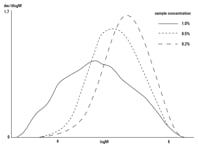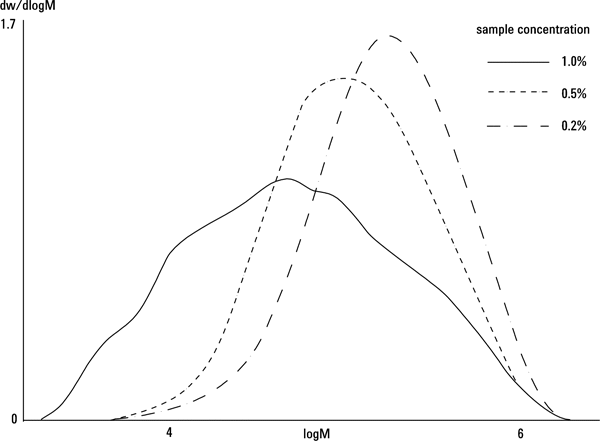Access Agilent eNewsletter, May 2014
>> Update My Profile | Subscribe to Access Agilent | Article Directory

Tips and tricks for Gel Permeation Chromatography
By Stephen Luke
Agilent GPC Columns Product Manager
Customer feedback is vital for the success of any business, particularly for suppliers of chromatography technology. To gain maximum advantage, information needs to be regularly exchanged between users and suppliers. This two-way communication helps you gain better value from your equipment and methods – and helps us design better products that meet your evolving needs. Sharing experience works to everyone’s benefit. This article highlights some of the recent issues fielded by the Agilent Technical Support team from Gel Permeation Chromatography (GPC) users.
Focus on sample concentration
In GPC, an appropriate sample concentration depends on molecular weight (MW), something to bear in mind if your background is in other forms of liquid chromatography. For high MW, use lower concentrations, and vice versa, as shown in Table 1. The effect of concentration on molecular weight distribution results from GPC is revealed in Figure 1. You can see that too high a sample concentration distorts results.
 Enlarge
Enlarge
Figure 1. The effect of sample concentration on molecular weight distribution in the GPC analysis of a broad polystyrene, using an Agilent PLgel 5 µm MIXED-C, 7.5 x 300 mm column.
MW Range |
Concentration |
|---|---|
100 – 10 k |
3 to 5 mg/mL (0.3 to 0.5%) |
10 k – 500 k |
2 mg/mL (0.2%) |
500 k – 800 k |
1 mg/mL (0.1%) |
800 k – low millions |
≤0.5 mg/mL (≤0.05%) |
Millions |
≤0.25 mg/mL (≤0.025%) |
Table 1. A guide to the relationship between molecular weight range and sample concentration.
Minimize the effects of exclusion limits
Knowing something of the expected MW range of your sample will also help you choose the correct GPC column for your analysis. Every column will have a documented MW range. Ideally, you want to use columns where the sample falls in the middle of the recommended range and not at either extreme – close to the exclusion or permeation limit.
Reduce retention times
It is common practice in GPC to use multiple 7.5 mm x 300 mm columns in series. This can result in typical run times up to and above 45 minutes. For high speed applications, however, short columns with a wider internal diameter – 10 mm x 100 mm – run at higher flow rates and can be a better choice.
Resolve high pressure issues
If you observe an increase in backpressure, it is worth dismantling the column set and then testing the columns individually for backpressure. This sometimes reveals that the pressure comes from only one of the columns, or simply from the guard column. You can also reverse the column, but do so individually.
To reduce backpressure you can operate the system at higher temperatures which will reduce solvent viscosity (also improving mass transfer and separation efficiency) and maintain sample solubility.
Transfer solvents successfully
Organic columns, such as Agilent PLgel, can be transferred easily and rapidly between solvents of varying polarity. The columns are shipped in ethyl benzene and can then be transferred to the solvent of your choice, depending on its viscosity, by first flushing with acetone as an intermediate solvent and then with the new solvent at a reduced flow rate. Elevated temperature can also be used for some solvents.
Agilent PolarGel polar/mixed columns are supplied in water containing sodium azide preservative. Intermediate solvents here are water and acetone. Reduced flow rate and elevated temperature are also used, depending on the desired water/organic/polarity composition of your final solvent.
Agilent PL aquagel-OH aqueous columns are also supplied with water containing azide, and so should be transferred to new solvents via pure water and then buffer, or pure water and then mixed solvent, as appropriate.
Keep watch on connections
The importance of proper size tubing and connections is sometimes overlooked in GPC. Tubing lengths should be kept short. Connections to columns and between columns should be made using fittings compatible with your solvent type and column design, and be regularly checked for leaks. Following the above tips will prevent excessive dead volumes that can cause peak broadening.
Agilent offers a full line of GPC/SEC solutions
These examples bring up some of the more common questions that our customers are keen to explore. Additional tips are available in the new, handy, and informative GPC wall chart Achieve more with the polymer analysis people. Order your free copy now.
You can also explore GPC techniques in more detail within the comprehensive Agilent portfolio of GPC/SEC instruments, columns, and calibrants for high performance separations. This link also gives you free access to application compendia, primers, and selection guides. What’s more, the Agilent Parts Finder tool helps you quickly locate replacement components when you are in need of instrument parts and supplies.
>> Update My Profile | Subscribe to Access Agilent | Article Directory
